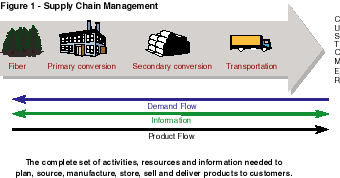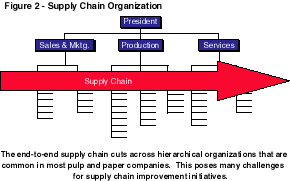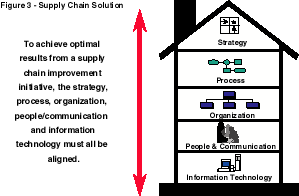|
Implementing supply chain management is not an easy task, but the benefits can be substantial for companies that make it work
By Scott McLean
Finding strategic advantage through SCM
For decades, the pulp and paper industry has focused on the supply side of its business and it has been generally successful in doing so. Historically, there has always been an overriding emphasis on output and the improvement of production capabilities. This has created a fundamental ‘supply push’ approach to the entire supply chain. In other words, producers in the sector have always been striving to push product to the market at the lowest possible unit cost.
Today, many other industries are using supply chain management (SCM) principles to turn things around and run their supply chains in a ‘demand pull’ manner. They are using customer demand information to drive the production/supply side of their business and they are reaping many significant benefits in the process. Benefits such as improved customer satisfaction, lower operating costs, increased throughput and dramatically reduced inventory are just a few of the advantages offered by SCM. Pulp and paper companies can capture many of the same benefits by adopting sound SCM practices and the first companies to do so will enjoy a significant strategic advantage.
Applying SCM principles challenges the way pulp and paper companies think about their business, encouraging them to discover solutions beyond their current operational perspective. Companies need to abandon the traditional functional approach to managing their businesses in favor of a process-oriented approach. In short, they have to manage their entire supply chain, not just specific parts along it.
The key to effectively managing a company’s supply chain is utilizing information regarding the flow or supply of product and customer demand. This information needs to be managed back and forth across the entire supply chain. An IT (information technology) solution provides unparalleled opportunities for the integration and co-ordination of such information. Implementing IT solutions can enable the orchestration of a vast array of activities across the entire supply chain. By sharing information in "real-time", the company has the advantage that when customers place orders, they can accurately plan production and proactively manage inventory levels and distribution activities. At the same time, companies can react to unexpected changes in customer demand or production schedules.
The benefits of applying sound SCM practices will provide companies with a competitive edge in the market place. SCM can lead to operating cost reductions, improved asset utilization and reduced inventory. But perhaps most importantly of all, customer satisfaction is enhanced. This is vital as today’s markets become increasingly customer driven. Giving customers what they want, where and when they want it as efficiently as possible, is the winning formula for doing business in practically any business sector.

What is it?
Supply chain management is a very simple, but powerful concept. It proposes that a company take an end-to-end perspective of its business processes. The examination of these processes starts with those associated with the acquisition of raw material and planning and works all the way through to the business processes for delivering finished products to the final consumer and receiving payment.
There are a wide variety of definitions of SCM, but one of the most comprehensive states that it is "the complete set of activities, resources and information needed to plan, source, manufacture, store, sell and deliver products to customers".
In order to manage a supply chain effectively, there are two distinct and important ‘flows’ which need to be managed. The first of these is the flow of product supply that runs through a supply chain and the second is the flow of demand. It should be noted that demand flows through a supply chain in the opposite direction from supply. As such, a tremendous amount of information must be shared back and forth across a supply chain if it is to be managed effectively. It is only in this way that a company can coordinate product flow activities to match customer demand. Sound SCM practices provide a company with the capability of balancing supply with demand.
For most pulp and paper companies, their supply chains extend well beyond the legal bounds of the company. Ultimately, the supply chain improvement efforts that such companies take on will require enhanced cooperation with their supply chain partners. But in the short term, there are usually many opportunities for improvement and associated benefits that can be achieved within a pulp and paper company - certainly enough to warrant getting started on a preliminary supply chain improvement initiative.
Process oriented
Most pulp and paper companies organize their people and manage their business processes within functional silos, or divisions. Sales, distribution, production planning, logistics and purchasing are all familiar titles of departments, each of which perform activities along the supply chain. Yet, individual department goals and objectives are often in conflict and hinder the effectiveness of a company’s SCM.
In sales, the objective is typically to respond to customer requests, which can lead to order jamming or other ‘heroic’ behavior, even if this has a negative impact on other components of the supply chain. The main objective in production planning is to maximize machine utilization, resulting in long production runs to minimize set-up times and costs that can lead to inventory build-ups. In turn, high service levels are the aim in distribution, which lead to greater volumes of finished goods being stored to prevent ‘stock outs’. The result is managing product flow as a series of independent activities. At best there is local optimization, but at the cost of inefficiencies in the overall supply chain.
The inherent conflicts generated by such business practices provide fertile ground for improvement initiatives. The need to integrate these different functions is clear and sound SCM practices will provide the foundation for running an efficient and effective supply chain.
SCM calls for a new mindset. The concept requires a process-oriented approach to managing a business. In other words, managing the end-to-end process, not just the individual functions. SCM cuts across functional lines, but most often companies do not place an emphasis on processes that cross functional lines. Consequently, there are few companies that have well thought out end-to-end supply chain processes.
SCM improvement initiatives for pulp and paper companies reveal that they are typically weak and quite often void in the areas of demand planning, production planning and scheduling, production reservation, inventory management, transportation planning and order optimization. Developing and optimizing these processes is the key to effective SCM.

Tough task
Unfortunately, establishing a process driven supply chain is far from easy. For many companies, implementing such a radical approach challenges the conventional hierarchical organizational structure that is typical of most pulp and paper companies. Organizational structures have natural defenders, whereas business processes are usually seldom spoken of.
Implementing an integrated end-to-end supply chain solution requires that business processes move to the forefront and the organizational structure be realigned so that the processes can function effectively. Similarly, the people that perform SCM activities and their communication mechanisms also need to be aligned for the supply chain to run effectively and efficiently. It is imperative that people learn how to work and communicate in ways that facilitate the supply chain processes. Work attitudes and the behavior of people are essential to making a supply chain work.
End-to-end process thinking is a radical change for many companies. Performance measures are an essential requirement in order to unite all of the people working within a company’s supply chain with common objectives. These measures need to be aligned right across the entire supply chain and more importantly, shared on an end-to-end basis.
In establishing performance measures, the objective is to encourage behavior that will support the company’s processes and its supply chain. The old adage "that which gets measured, gets done" applies here.
Moreover, performance measures indicate how well various supply chain processes are being managed holistically and identify inefficiencies. For example, one company that implemented a revised invoice error performance measure included reason codes to identify the source of the mistake. In doing so, the group revealed that many of the problems and improvement opportunities originated in shipping.
In order to create meaningful supply chain improvements, it is important that any improvement initiative has the right scope - ie one that reaches beyond an existing functional silo. For example, a functional approach to improving warehouse productivity would be to introduce initiatives aimed at reducing warehouse handling costs. In contrast, a wider, end-to-end SCM initiative would question whether all of the existing warehouses are needed and develop business processes to harmonize warehouse management activities with sales, production and transportation activities.
SCM initiatives can generate significant benefits, but in order to generate meaningful improvement they must have a scope that crosses existing functional silos and sponsorship which is prepared to question and consider modifying the existing organizational structure.
IT enabler
For a supply chain to function efficiently and effectively, a tremendous amount of information must be shared across the supply chain from one end to the other. Rapid dissemination of accurate information is crucial to SCM, which makes IT a powerful SCM enabler. Technical advances, enhanced computer memory, cost reductions in computing capabilities and lower cost communication channels have made it increasingly economical to utilize the powerful supply chain solutions that software developers continue to create.
Implementing packaged IT solutions for SCM offers a company the capability to handle day-to-day transactions across the supply chain. There are suites of software solutions that can integrate demand planning, order capture, production scheduling, resource allocation and distribution. In addition, the same software solutions have the capability to model a supply chain and run "what if" scenarios to compare supply chain responses and assist in developing the optimal approach for responding to changes.
SCM IT solutions are very enticing because of the many benefits that they can provide, but they are usually quite challenging to implement successfully in order to capture the potential gains. Companies that succeed in implementing SCM IT solutions are those that have a clear vision of how they intend to manage their supply chain prior to selecting a SCM software solution. It is also important to have a strong business case to warrant the implementation, solid executive sponsorship of the initiative and to put an emphasis on change management throughout the implementation.
A well thought out SCM approach enabled by IT will provide the capability to deliver what customers want, where and when they want it, as efficiently as possible - the underlying theme of successful supply chain management.
One example of an IT solution that led to the broad use of end-to-end supply chain information is highlighted by a paper company that identified the need for a production planning and reservation modeling tool. The company expected the tool to be used by the company’s sales team and mill production planning. As such, the company implemented a tool which combined sales forecast, production planning and sales order information. But following the implementation, a broad array of users accessed the information available in the modeling tool on a regular basis. Maintenance used it to access timely, accurate information on when machines were scheduled to be down. Shipping used the information to accurately schedule crews based on an accurate production plan, and purchasing used the information on planned production to schedule purchases and coordinate deliveries. Moreover, mill managers were found to be using the tool to gain an up-to-date picture of planned production, while sales executives used the tool as a "real time" view of the order file.
The implementation was so successful that the company decided to implement further functionality to incorporate distribution planning and execution as well as inventory management to further enable their SCM capabilities.

Optimizing the chain
Supply chain optimization becomes possible once a company has clearly defined the end-to-end supply chain processes and has the ability to rapidly assess the impact of supply chain scenarios to determine the optimal response.
Optimization across an entire supply chain means having the ability to respond rapidly to changes because even the best laid plans can go amiss - customers change their minds, paper machines can go down and fiber quality is variable. For example, when a paper machine goes down unexpectedly there is vital information which must travel across the supply chain so that distribution plans can be revised, customers can be notified and orders can be rescheduled. In order to optimize a supply chain, it is imperative that a company has an end-to-end perspective of its supply chain and the ability to rapidly evaluate the impact of any changes right the way through all the different individual processes. The company must also have established mechanisms to agree on an optimal solution and the will to take action quickly.
SCM can deliver high dividends and these come in many forms. Improved cycle times achieved through an integrated, process driven supply chain means order lead times can be reduced and the time from the receipt of an order to the receipt of cash can be substantially reduced. Invariably, customer service is also improved. Inventory levels come down as well, as stocks are replaced with information. Lower inventory levels lead to much improved return on capital employed.
The impact on overall performance can be dramatic. Other industries have experienced dramatic improvements by adopting SCM principles and the groups that were first to start implementing the principles of SCM in the pulp and paper industry are already beginning to enjoy the benefits of their efforts.
SCM is a simple, but powerful, concept. First and foremost, it requires that a company understands the end-to-end processes that make up its supply chain and then proactively move toward improving the processes. IT is a very effective SCM enabler. IT supports rapid sharing of information back and forth across a supply chain, allowing a company to respond to changes quickly and introducing it to enter into the profit enhancing world of optimization.
However, it is crucial to recognize that while powerful SCM IT solutions are available, the key is to determine how a company should run its supply chain before blindly selecting SCM software. IT is a business-enabling tool, not a complete business solution. Even the most sophisticated technology cannot overcome an inefficient ‘broken’ supply chain. IT enables a company to maximize the available benefits, but it is only by introducing sound SCM practices that a business can be empowered.
Thinking on
Imagine running your business like a well-trained track relay team. It requires a coordinated effort to win the race and the team is most competitive, most successful when each runner is capable not only of running their respective leg quickly, but also in executing seamless handoffs. If the team isn’t excellent at handoffs, it will never win the race. Applying SCM principles to your business will give you the competitive edge to make your company a winner.
R Scott McLeanis a principal consultant at PricewaterhouseCoopers Global Forest & Paper Practice. McLean is Supply Chain Management Practice Leader for the group, working for pulp, paper, packaging and solid wood companies in Europe, Australasia and throughout North America. McLean is based in Vancouver, Canada
|